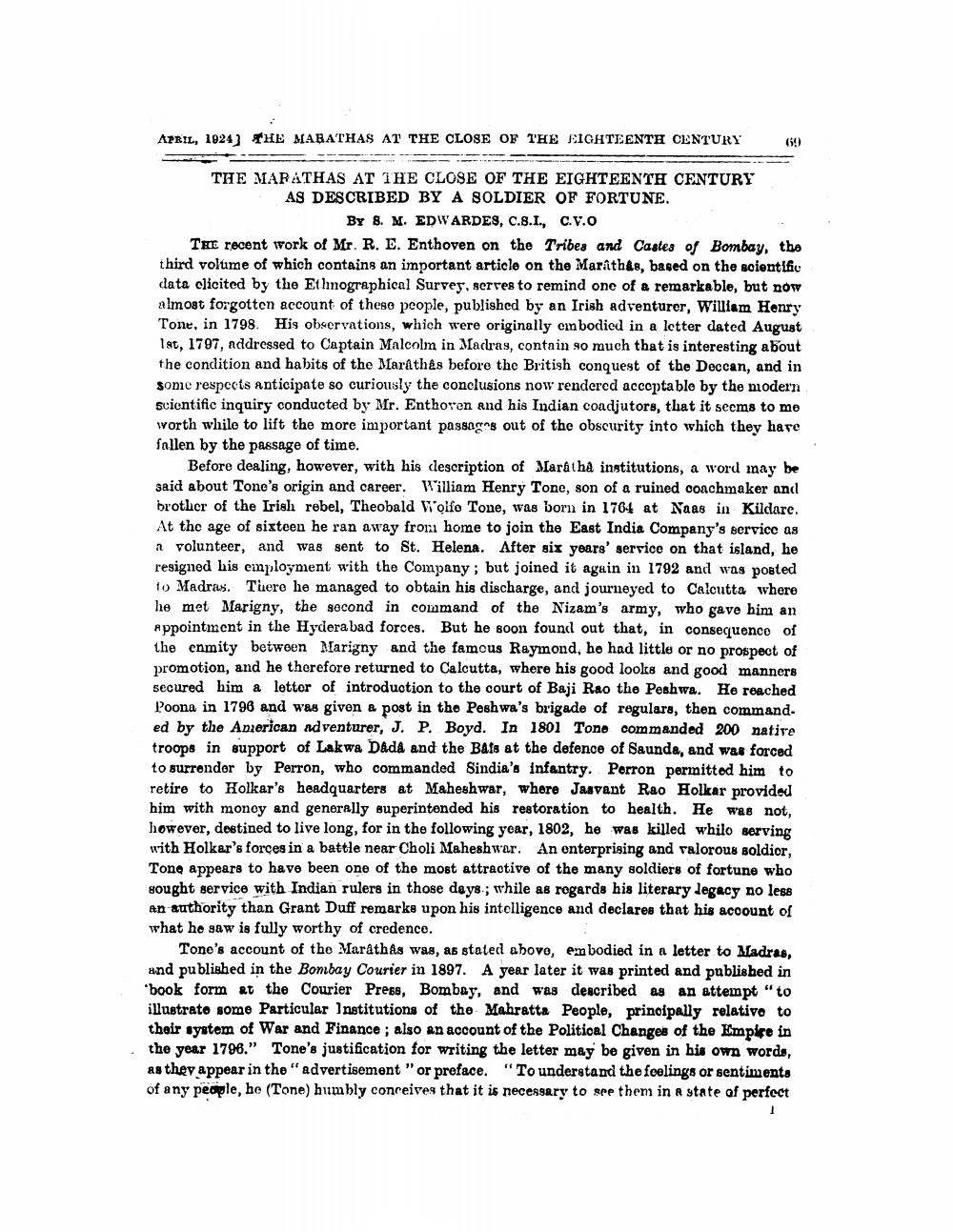________________
APRIL, 1924] THE MARATHAS AT THE CLOSE OF THE EIGHTEENTH CENTURY
THE MARATHAS AT THE CLOSE OF THE EIGHTEENTH CENTURY AS DESCRIBED BY A SOLDIER OF FORTUNE.
BY 8. M. EDWARDES, C.S.I., C.V.O
THE recent work of Mr. R. E. Enthoven on the Tribes and Castes of Bombay, the third volume of which contains an important article on the Marathas, based on the scientific data elicited by the Ethnographical Survey, serves to remind one of a remarkable, but now almost forgotten account of these people, published by an Irish adventurer, William Henry Tone, in 1798. His observations, which were originally embodied in a letter dated August 1st, 1797, addressed to Captain Malcolm in Madras, contain so much that is interesting about the condition and habits of the Marathas before the British conquest of the Deccan, and in some respects anticipate so curiously the conclusions now rendered acceptable by the modern Scientific inquiry conducted by Mr. Enthoven and his Indian coadjutors, that it seems to me worth while to lift the more important passages out of the obscurity into which they have fallen by the passage of time.
69
Before dealing, however, with his description of Maratha institutions, a word may be said about Tone's origin and career. William Henry Tone, son of a ruined coachmaker and brother of the Irish rebel, Theobald Wolfe Tone, was born in 1764 at Naas in Kildare. At the age of sixteen he ran away from home to join the East India Company's service as a volunteer, and was sent to St. Helena. After six years' service on that island, he resigned his employment with the Company; but joined it again in 1792 and was posted to Madras. There he managed to obtain his discharge, and journeyed to Calcutta where he met Marigny, the second in command of the Nizam's army, who gave him an appointment in the Hyderabad forces. But he soon found out that, in consequence of the enmity between Marigny and the famous Raymond, he had little or no prospect of promotion, and he therefore returned to Calcutta, where his good looks and good manners secured him a letter of introduction to the court of Baji Rao the Peshwa. He reached Poona in 1796 and was given a post in the Peshwa's brigade of regulars, then commanded by the American adventurer, J. P. Boyd. In 1801 Tone commanded 200 native troops in support of Lakwa Dada and the Bats at the defence of Saunda, and was forced to surrender by Perron, who commanded Sindia's infantry. Perron permitted him to retire to Holkar's headquarters at Maheshwar, where Jasvant Rao Holkar provided him with money and generally superintended his restoration to health. He was not, however, destined to live long, for in the following year, 1802, he was killed whilo serving with Holkar's forces in a battle near Choli Maheshwar. An enterprising and valorous soldier, Tone appears to have been one of the most attractive of the many soldiers of fortune who sought service with Indian rulers in those days; while as regards his literary legacy no less an authority than Grant Duff remarks upon his intelligence and declares that his account of what he saw is fully worthy of credence.
Tone's account of the Marathas was, as stated above, embodied in a letter to Madras, and published in the Bombay Courier in 1897. A year later it was printed and published in 'book form at the Courier Press, Bombay, and was described as an attempt "to illustrate some Particular Institutions of the Mahratta People, principally relative to their system of War and Finance; also an account of the Political Changes of the Empire in the year 1796." Tone's justification for writing the letter may be given in his own words, as they appear in the "advertisement "or preface. "To understand the feelings or sentiments of any people, he (Tone) humbly conceives that it is necessary to see them in a state of perfect
1




